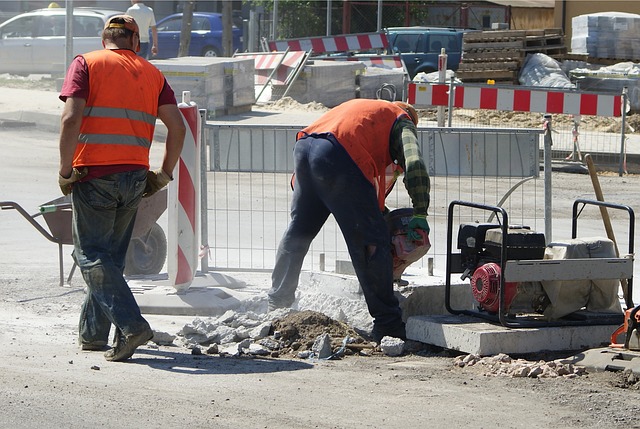Foundation sinking, driven by clay-based soils, moisture changes, subpar construction, and groundwater fluctuations, leads to structural damage like cracks, uneven floors, and potential collapse. Early signs include visible wall/floor cracks, uneven floors, misaligned doors/windows, ceiling bulges, and sudden wall/ceiling cracks. Regular visual inspections are vital; professional assessment is crucial if serious damage like stuck doors, sloping walls, or cracks exceeding 1/4 inch is observed. Prompt action through Residential Foundation Repair prevents further deterioration, costly renovations, and structural instability caused by soil shifting and water intrusion.
Foundation sinking is a serious issue that requires prompt attention. This comprehensive guide delves into the critical indicators of foundation instability, empowering homeowners to recognize early signs. From visible cracks and misaligned doors to uneven flooring and water intrusion, understanding these red flags is key to preventing structural damage. Learn when it’s time to seek professional residential foundation repair for a stable and secure home.
Understanding Foundation Sinking: Common Causes and Effects

Foundation sinking, a subtle yet significant issue, is a common concern for homeowners, often leading to more extensive and costly residential foundation repair. Understanding this phenomenon begins with recognizing its causes, which are typically rooted in the unique interactions between the soil, structural design, and environmental factors. One of the primary culprits is soil settlement, where certain types of soil, like clay, shrink or expand based on moisture content changes, causing the foundation to shift over time.
Other contributing factors include poor initial construction, such as inadequate depth or improper compaction of the foundation footings, as well as changes in groundwater levels and underground drainage patterns. The effects of sinking foundations are far-reaching, resulting in cracks in walls and ceilings, uneven floors, stuck doors and windows, and even structural damage that requires comprehensive residential foundation repair solutions. Early detection through regular inspections is key to mitigating these issues before they escalate.
Early Detection: Recognizing Signs of Foundation Instability

Recognizing early signs of foundation instability is crucial for effective residential foundation repair. Indicators like visible cracks in walls, uneven floors, or doors that stick or swing slightly can signal underlying problems with soil shifting or water intrusion. Homeowners should also be alert to noticeable changes in ceiling tiles, such as bulges or warping, which may point to settling or structural damage. Regular inspection is key; even minor discrepancies warrant further investigation to prevent more severe and costly damages over time.
Timely intervention through professional evaluation can prevent the progression of these indicators into major structural issues. Prompt action on red flags like these will help ensure the longevity and stability of a home’s foundation, averting the need for extensive residential foundation repair in the future.
Visual Inspection: Identifying Visible Indicators of Sinking

A visual inspection is often the first step in identifying whether a residential foundation is sinking. There are several visible indicators that can signal a problem. Cracks in the foundation walls or floor, uneven floors, and doors or windows that stick or don’t align properly are all common signs of sinkage. These issues may be evident during a routine walk-through inspection or when compared to previous photos or records of the property.
Homeowners should also look for bulges or inclinations in the foundation walls, as these can indicate areas of weakness and potential sinking. If any part of the structure appears distorted or uneven, it’s crucial to contact a professional for an assessment. Early detection through visual inspection is key to mitigating potential damage and preventing the need for costly residential foundation repair.
Structural Damage: When Cracks Appear on Walls and Ceilings

When it comes to assessing a sinking foundation, one of the most visible indicators is the sudden appearance of cracks on walls and ceilings. These structural damage signs can be a red flag for homeowners, signaling potential problems with their residential foundation repair. Cracks may vary in size and shape, from thin lines to wide gaps, and they can occur in various parts of a home, including corners, joints, or across entire sections.
The emergence of these cracks is often an early warning system for underlying issues like settlement, heave, or uneven soil conditions. Over time, the continuous movement of the soil beneath a house can cause the foundation to shift, leading to structural instability and subsequent damage. Prompt action is crucial; addressing the problem early through professional residential foundation repair methods can prevent further deterioration and costly renovations.
Door and Window Problems: Misalignment as a Potential Warning Sign

Door and window problems, such as misaligned frames or stuck hinges, could indicate a sinking foundation. As residential foundation repair experts know, even seemingly minor issues like these can signal more significant structural concerns below the surface. Over time, uneven settling can cause doors and windows to become misaligned, resulting in gaps or difficulty opening and closing.
These visible problems are often the first warning signs for homeowners. If you notice any doors or windows that don’t open or close smoothly, or if there are irregular gaps around their frames, it’s worth investigating further. Addressing these issues promptly can help prevent more severe foundation damage and costly repairs down the line, making regular checks a crucial part of maintaining your home’s structural integrity.
Uneven Flooring: The Tell-Tale Sign of Foundation Movement

Uneven flooring is a clear indicator that your home’s foundation might be sinking or experiencing movement. When a residential foundation repair becomes necessary, one of the most visible signs is uneven or distorted floors. This can manifest as warped or buckling floorboards, uneven tiles, or doors and windows that stick or fail to close properly. Such issues often point to more severe structural problems, including settlement or heave caused by changes in soil conditions or poor initial construction.
Regularly inspecting your home for signs of foundation movement is crucial for prompt residential foundation repair. Addressing the issue early can prevent further damage and costly repairs down the line. If you notice any uneven flooring, it’s essential to consult with a professional who specializes in foundation repair to diagnose the problem accurately and provide effective solutions tailored to your specific situation.
Water Intrusion: Leaks and Their Connection to Foundation Sinking

Water intrusion is a common and serious issue that often goes hand in hand with foundation sinking. Leaks, whether from pipes, appliances, or cracks in the structure, can significantly contribute to this problem. When water seeps into the soil around a home’s foundation, it increases the moisture content, causing the earth to expand and contract. Over time, this movement exerts pressure on the foundation, leading to cracks and an uneven surface.
In residential areas, where homes are typically built on various types of soil, water intrusion can be a significant factor in the deterioration of foundations. If left unaddressed, these leaks can result in extensive damage, including structural instability and even the need for costly residential foundation repair. Identifying and repairing leaks promptly is, therefore, an essential step in preventing further foundation sinking and ensuring the longevity of any home.
Professional Assessment: When to Call for Residential Foundation Repair

A professional assessment is an essential step in determining if your residential foundation requires repair. While minor cracks and settling are common and usually harmless, more significant issues can indicate serious structural damage. If you notice uneven floors, doors or windows that stick or close improperly, sloping walls, or visible cracks exceeding 1/4 inch (0.6 cm), it’s time to contact a professional for a thorough inspection.
Professionals use advanced tools and methods to evaluate foundation health, including moisture meters, laser levels, and radar scanning. They will assess the extent of damage, identify the root causes, and recommend appropriate repair solutions. Timely intervention can prevent further deterioration, costly repairs, or even structural collapse by addressing issues like settlement, heave, or differential settling.
